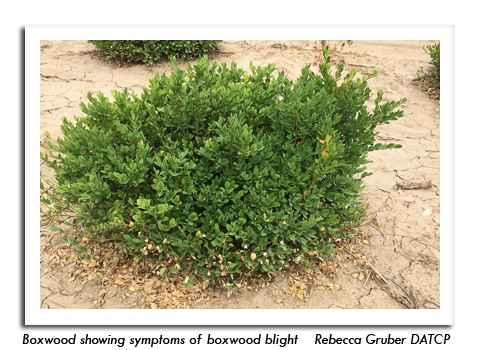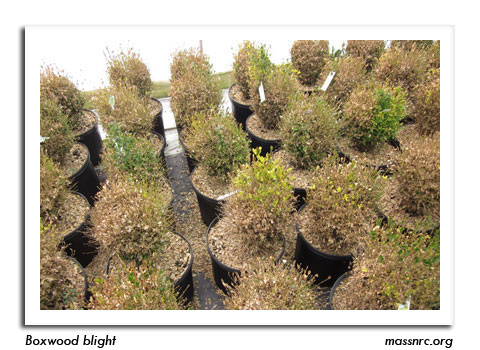
 |
|
|
Nursery & Forest
Volume 63 Number 14 Date 08/02/2018 BOXWOOD BLIGHT - This fungal disease has been confirmed on boxwood at a nursery grower in Kenosha County, the first detection in Wisconsin. Boxwood blight can be caused by two species of fungi in the genus Calonectria: C. pseudonaviculata occurs in North America, while a second species has been found in Europe. Molecular work is currently being conducted on the Wisconsin find for species confirmation. Other members of the family Buxaceae known to be susceptible to boxwood blight include genera Pachysandra and Sarcococca. Symptoms of boxwood blight on boxwood begin as brown spots or lesions on the leaves, which eventually coalesce and cause defoliation. Infected stems develop dark brown-to-black lesions. White fungal spores visible to the naked eye are produced on the undersides of infected leaves and on the stem lesions. The pathway for long-distance dispersal of this pathogen is likely through the movement of infected nursery stock, or tools and equipment. Natural movement of this pathogen occurs over relatively short distances by rain splash or mobile organisms like birds. Spores can remain viable for six years on plant debris or in the soil. Following official boxwood blight confirmation by the USDA, all production fields containing boxwood at the nursery grower were thoroughly sampled. Wisconsin DATCP nursery inspectors have been working closely with the grower to ensure that all fields containing infected boxwood will be effectively managed. Elimination of this pathogen requires the destruction of the host plant by burial or burning. Apparently asymptomatic, healthy stock will be held and monitored closely to ensure it is free from the pathogen. In addition, customers who may have received infected stock are being contacted by the nursery grower. Residents who suspect boxwood blight on recently-purchased boxwoods are advised to contact their county Extension office. For more information visit the DATCP Boxwood Blight webpage. -- DATCP Nursery Program and Plant Industry Bureau Lab (Marcia Wensing, Rebecca Gruber, Liz Meils, Anette Phibbs, Shahla Werner, and Shanon Hankin) HAZELNUT BACTERIAL BLIGHT - Hazelnut bacterial blight was found on hazelnut trees at a nursery grower in Dane County. Caused by the pathogen Xanthomonas arboricola pv. corylina, this disease tends to be more severe in young trees (under six years) or older, stressed trees. Symptoms include angular and circular necrotic leaf spots surrounded by yellowing that turns reddish-brown later in the season. Cankers that commonly ooze in spring may appear on stems and the trunk. The bacteria enters the tree through openings or wounds in the main trunk, branches, or buds. These openings can be naturally occurring or can be induced by abrupt changes in weather (frost cracks) or mechanically induced by nursery equipment. This disease can be spread by infected nursery stock, equipment, and rain splash. Management of this blight can include cultural methods such as purchasing clean stock, protecting trees from mechanical damage, equipment sanitation, and pruning of infected branches a significant distance below the infection. Application of an approved bactericide may be used for severe cases. VINYL-SPIRAL-TREE GUARDS - Certain brands of vinyl-spiral-tree guards intended to protect young trees from rabbits, rodents and mechanical injury do not expand as the tree grows and can constrict and girdle the trees if not adjusted seasonally. Trees with severe constriction are often found with dead vascular tissue in the trunk, which can lead to infection by a range of diseases that cause tree decline. Homeowners, landscapers, and nurseries who use spiral guards must inspect the trunks periodically to determine if the guards need to be adjusted. -- Shanon Hankin, DATCP Nursery Inspector 


|
|
|